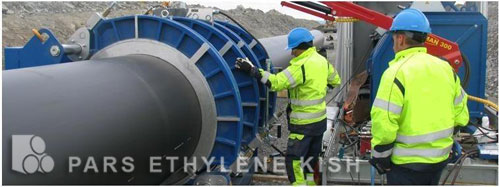
Polyethylene Joining Procedures
Butt Fusion Joining Procedure for Field Joining of Polyethylene Pipe
An integral part of any pipe system is the method used to join the system components. Proper engineering design of a system will take into consideration the type and effectiveness of the techniques used to join the piping components and appurtenances, as well as the durability of the resulting joints. The integrity and versatility of the joining techniques used for polyethylene pipe allow the designer to take advantage of the performance benefits of polyethylene in a wide variety of applications.
General Provisions
Polyethylene pipe or fittings are joined to each other by heat fusion or with mechanical fittings. Polyethylene may be joined to other materials by means of compression fittings, flanges, or other quilted types of manufactured transition fittings. There are many types and styles of fittings available from which the user may choose. Each offers its particular advantages and limitations for each joining situation the user may encounter. Contact with the various manufacturers is advisable for guidance in proper applications and styles available for joining as described in this document. There will be joining methods discussed in this document covering both large and small diameter pipe. Large diameter pipe is considered to be sizes 3" IPS (3.500" OD) and larger. Those persons who are involved in joining gas piping systems must note certain qualification requirements of the U.S. Department of Transportation Pipeline Safety Regulations.
Thermal Heat Fusion Methods
There are three types of heat fusion joints currently used in the industry; Butt, Saddle, and Socket Fusion. Additionally, there are two methods for producing the socket and saddle heat fusion joints.
The principle of heat fusion is to heat two surfaces to a designated temperature, and then fuse them together by application of a sufficient force.
This force causes the melted materials to flow and mix, thereby resulting in fusion. When fused according to the pipe and/or fitting manufacturers procedures, the joint area becomes as strong as, or strongAer than, the pipe itself in both tensile and pressure properties. As soon as the joint cools to near ambient temperature, it is ready for handling. The following sections of this chapter provide a general procedural guideline for each of these heat fusion methods.
• Download Polyethylene joinin Procedure »
We suggest visit HDPE Fitting Catalogue page
Polyethylene pipe welding and polyethylene fittings- Welding of polyethylene pipes




